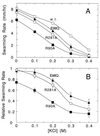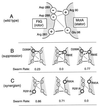Electrostatic interactions between rotor and stator in the bacterial flagellar motor
- PMID: 9600984
- PMCID: PMC27776
- DOI: 10.1073/pnas.95.11.6436
Electrostatic interactions between rotor and stator in the bacterial flagellar motor
Abstract
Bacterial flagellar motors rotate, obtaining power from the membrane gradient of protons or, in some species, sodium ions. Torque generation in the flagellar motor must involve interactions between components of the rotor and components of the stator. Sites of interaction between the rotor and stator have not been identified. Mutational studies of the rotor protein FliG and the stator protein MotA showed that both proteins contain charged residues essential for motor rotation. This suggests that functionally important electrostatic interactions might occur between the rotor and stator. To test this proposal, we examined double mutants with charged-residue substitutions in both the rotor protein FliG and the stator protein MotA. Several combinations of FliG mutations with MotA mutations exhibited strong synergism, whereas others showed strong suppression, in a pattern that indicates that the functionally important charged residues of FliG interact with those of MotA. These results identify a functionally important site of interaction between the rotor and stator and suggest a hypothesis for electrostatic interactions at the rotor-stator interface.
Figures




Similar articles
-
Roles of charged residues of rotor and stator in flagellar rotation: comparative study using H+-driven and Na+-driven motors in Escherichia coli.J Bacteriol. 2006 Feb;188(4):1466-72. doi: 10.1128/JB.188.4.1466-1472.2006. J Bacteriol. 2006. PMID: 16452430 Free PMC article.
-
Distinct roles of highly conserved charged residues at the MotA-FliG interface in bacterial flagellar motor rotation.J Bacteriol. 2013 Feb;195(3):474-81. doi: 10.1128/JB.01971-12. Epub 2012 Nov 16. J Bacteriol. 2013. PMID: 23161029 Free PMC article.
-
Contribution of many charged residues at the stator-rotor interface of the Na+-driven flagellar motor to torque generation in Vibrio alginolyticus.J Bacteriol. 2014 Apr;196(7):1377-85. doi: 10.1128/JB.01392-13. Epub 2014 Jan 24. J Bacteriol. 2014. PMID: 24464458 Free PMC article.
-
Structure and function of the bi-directional bacterial flagellar motor.Biomolecules. 2014 Feb 18;4(1):217-34. doi: 10.3390/biom4010217. Biomolecules. 2014. PMID: 24970213 Free PMC article. Review.
-
Tuning the flagellar motor.Microbiology (Reading). 2010 May;156(Pt 5):1275-1283. doi: 10.1099/mic.0.029595-0. Epub 2010 Mar 4. Microbiology (Reading). 2010. PMID: 20203052 Review.
Cited by
-
Mechanosensitive remodeling of the bacterial flagellar motor is independent of direction of rotation.Proc Natl Acad Sci U S A. 2021 Apr 13;118(15):e2024608118. doi: 10.1073/pnas.2024608118. Proc Natl Acad Sci U S A. 2021. PMID: 33876769 Free PMC article.
-
Site-Directed Cross-Linking Between Bacterial Flagellar Motor Proteins In Vivo.Methods Mol Biol. 2023;2646:71-82. doi: 10.1007/978-1-0716-3060-0_7. Methods Mol Biol. 2023. PMID: 36842107
-
Crystal structure of the middle and C-terminal domains of the flagellar rotor protein FliG.EMBO J. 2002 Jul 1;21(13):3225-34. doi: 10.1093/emboj/cdf332. EMBO J. 2002. PMID: 12093724 Free PMC article.
-
The Periplasmic Domain of the Ion-Conducting Stator of Bacterial Flagella Regulates Force Generation.Front Microbiol. 2022 Apr 27;13:869187. doi: 10.3389/fmicb.2022.869187. eCollection 2022. Front Microbiol. 2022. PMID: 35572622 Free PMC article. Review.
-
Coupling ion specificity of chimeras between H(+)- and Na(+)-driven motor proteins, MotB and PomB, in Vibrio polar flagella.EMBO J. 2000 Jul 17;19(14):3639-48. doi: 10.1093/emboj/19.14.3639. EMBO J. 2000. PMID: 10899118 Free PMC article.
References
-
- Blair D F. Annu Rev Microbiol. 1995;49:489–522. - PubMed
-
- Macnab R M. In: Escherichia coli and Salmonella, Cell and Molecular Biology. Neidhardt F C, editor. Washington, DC: Am. Soc. Microbiol.; 1995. pp. 123–145.
-
- Matsuura S, Shioi J-I, Imae Y. FEBS Lett. 1977;82:187–190. - PubMed
-
- Glagolev A N, Skulachev V P. Nature (London) 1978;272:280–282. - PubMed
Publication types
MeSH terms
Grants and funding
LinkOut - more resources
Full Text Sources
Molecular Biology Databases

